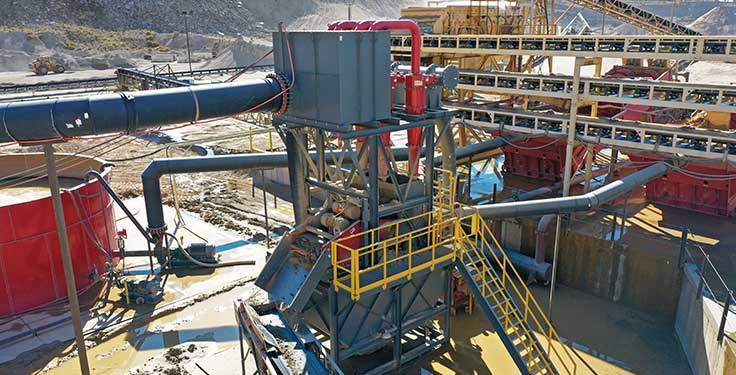Staker Parson cleans agg, reduces waste with right equipment

Staker Parson’s UltraFines recovery system from McLanahan Corp. reduces pond waste. Photo: McLanahan Corp.
Staker Parson Materials & Construction has produced sand, rock, ready-mixed concrete, asphalt, paving, construction and landscape products in the Western U.S. since 1952.
Today, the company operates more than 50 locations throughout Utah, Idaho, Oregon, Nevada and Arizona, delivering products for projects ranging from roadways to playgrounds.
Challenges on-site
Staker Parson, a CRH company, processes more than 1 million tons of aggregates per year for concrete and asphalt products at the company’s location in Brigham City, Utah. It operated a rinse plant and single 54-in. screw washer to clean the rock and mason sand byproduct used in its ready-mixed concrete and hot-mix asphalt plants.
But as Staker Parson began mining further into its bank, the material was getting noticeably dirtier and required more than rinsing to meet the specifications needed to create the company’s end products.
“We needed to start producing clean concrete sand, so we had to wash our concrete sand and produce a clean rock, as well,” says Brooks Hess, superintendent at Staker Parson.
Equipment-based solutions
Staker Parson reached out to Kimball Equipment, McLanahan Corp.’s Utah-based equipment dealer, as well as a few other vendors, to see which options were available for washing its sand.

Says Staker Parson’s Chad Beimer: “The thickener system works really great in recycling the water and pumping out the mud.” Photo: McLanahan Corp.
The company visited a site operating McLanahan equipment and submitted samples of its bank feed to McLanahan’s applications and research laboratory in Hollidaysburg, Pennsylvania, for testing.
McLanahan’s lab technicians performed an analysis of the material, including a sieve test to determine the particle size distribution of the feed, and its process engineering team assembled an equipment solution for the Brigham City site.
“We ended up liking the McLanahan system and everything they had to offer better, so that’s the route we went,” Hess says.
To help clean its concrete sand, Staker Parson installed two McLanahan 54-in. fine material double screw washers, followed by two McLanahan UltraDry dewatering screens to reduce moisture content in the final sand product.
Additionally, Staker Parson installed a McLanahan UltraFines recovery (UFR) system to reduce pond waste, as well as a thickener to recover water from the waste stream for reuse and to keep the excess water from filling up its pond too quickly. Both the UFR and thickener are designed to improve sustainability at the Brigham City site.
Hess says the equipment installation was “labor intensive,” and there were some learning curves with the equipment. But the support received from McLanahan and Kimball made the process go smoothly.
“The support has been amazing, honestly,” Hess says. “Kimball was here almost every day through the installation process, and the McLanahan team also came out for a few weeks, as well. They’ve been great as far as phone calls and anything else we needed from the support side.”
Delivering results
The new equipment has been performing well since start-up, and foreman Chad Beimer says the company hasn’t yet experienced any major issues with it.
“Start-up and shutdown are fairly simple,” Beimer says. “It takes no time at all, really.”

Staker Parson installed two 54-in. fine material double screw washers and two UltraDry dewatering screens – all from McLanahan Corp. – at its location in Brigham City, Utah. Photo: McLanahan Corp.
With its new wash plant, Staker Parson is now able to process 1,000 tph of material – a significant increase from the 400 tph yielded with its old setup.
The site’s new screw washers and dewatering screens allow Staker Parson to produce the clean, dry material needed for its ready-mix plants, and the UFR and thickener allow it to recover fine material and reusable process water from its waste stream.
“The thickener system works really great in recycling the water and pumping out the mud,” Beimer says.
While the main goals of producing clean material and reducing pond waste have been achieved, Hess says Staker Parson soon realized another benefit of the plant.
“With the McLanahan system, we’ll be able to utilize more material,” Hess says. “We went from as short as eight to 12 years to now we should be able to get at least 15 to 30 years out of our reserves, because we’re going to be able to utilize all of the material with the McLanahan wash plant.”
Hess describes McLanahan’s service as “very quick” and says he is “overall, very happy and very pleased” with the manufacturer’s equipment and assistance on-site.
“What I like best about the McLanahan equipment is the reliability and the quick assistance that you receive from them,” Beimer says. “Any questions or problems that we’ve come across, they’re quick to give us help and assistance.”
Information for this article courtesy of McLanahan Corp.









